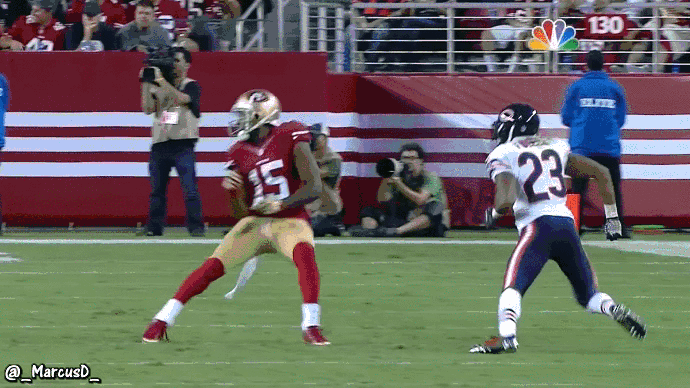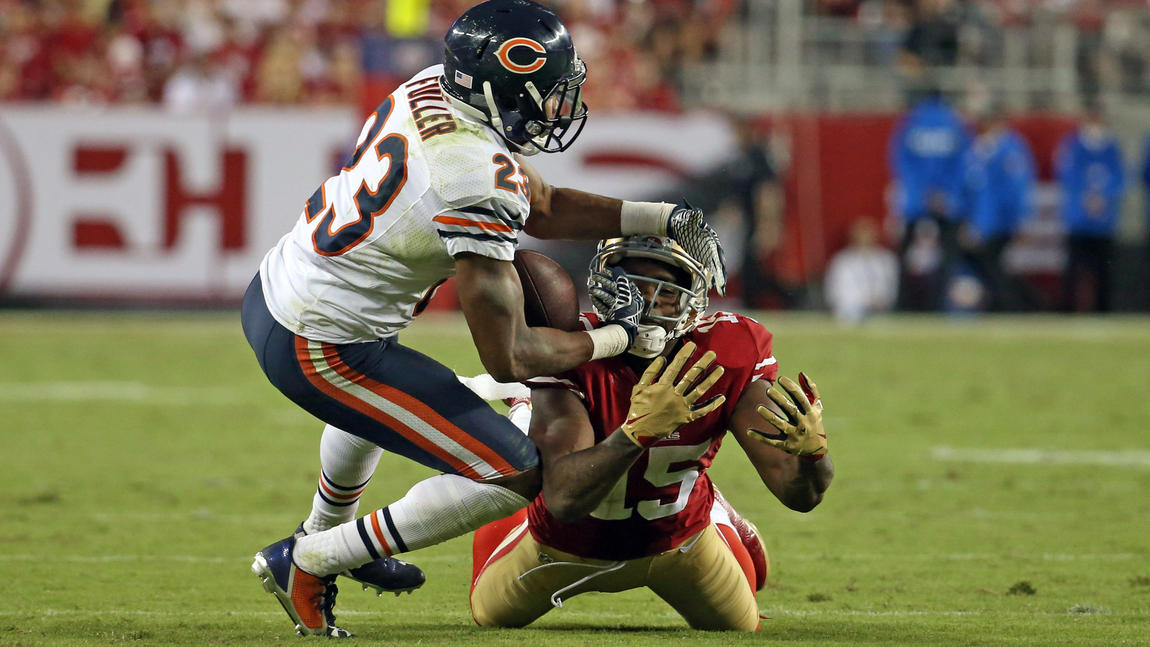Sunday night, the Bears beat the San Francisco 49ers—a team that has made it to the NFC Championship each of the past three seasons—in the 49ers' new stadium on their opening night and with a score no one expected (except Mike Ditka, apparently).
With two minutes left in the second quarter, the Bears trailed San Francisco by 17 points. The last time they overcame a road deficit that large was in 2006, against the Arizona Cardinals. In that game, they started the second half trailing 20-0 and ended winning 24-23, thanks to two fumble returns for touchdowns, as well as this:
All resulting, thankfully, in this…
That team went 13-3 that season and went to the Super Bowl. They had Lovie Smith on the sidelines, Rex Grossman under center, and Brian Urlacher and Devin Hester both at the peak of their powers. The only similarity with the team that played this Sunday is the uniforms.
And still, in a seemingly predetermined Bears way, this team won because of the defense—not a good one but a timely one. The defense forced one fumble and three interceptions, two of which came in the fourth quarter and led to touchdowns.
You can’t overstate the impact of turnovers, especially late in games. A takeaway is the best possible outcome for a defense. Enough of them, and a poor defense (and the Bears have that) becomes a good one. A good defense becomes a great one. Gather enough and avoid providing them, and history shows that you’re nearly a lock for success.
Let’s jump to an early conclusion and say that the 2014 Bears are a team predicated on takeaways. With only two games into the season, the sample size is small, but the Bears lost at home to an inferior opponent with a -2 turnover ratio, then won on the road against a perennial Super Bowl contender thanks to a +4 turnover ratio. With their fire-driven offense, the Bears can beat anybody if they take the ball away. That’s true for most teams, but especially teams with otherwise poor defenses.
Football Outsiders measures the efficiency of a team’s offense and defense using the metric DVOA, which stands for Defensive-Adjusted Value Over Average. Basically, it measures a team’s offensive and defensive effectiveness over the course of the season. Here's their summary of the system:
DVOA breaks down the entire season play-by-play, comparing success on each play to the league average based on a number of variables including down, distance, location on field, current score gap, quarter, and opponent quality. While it can be used as a measure of total team performance, it differs from other power ratings found throughout the Web because it can be broken down to analyze team effectiveness in any number of ways: down, quarter, rushing vs. receiving, location on field, passes to backs vs. passes to receivers, and so on."
Since 2004, ten teams have amassed a turnover ratio of +20 or higher over the course of a season.
| Year | Team | Turnover Margin |
|---|---|---|
| 2011 | San Francisco 49ers | +28 |
| 2010 | New England Patriots | +28 |
| 2012 | New England Patriots | +25 |
| 2011 | Green Bay Packers | +24 |
| 2009 | Green Bay Packers | +24 |
| 2007 | San Diego Chargers | +24 |
| 2005 | Cincinnati Bengals | +24 |
| 2012 | Chicago Bears | +20 |
| 2013 | Seattle Seahawks | +20 |
| 2005 | Denver Broncos | +20 |
Of those ten teams, seven were fantastic defensive units, ranking near the top of the league in Defensive DVOA. Good defenses create pressure and force turnovers, so the correlation between the rankings and the turnover margins is understandable. The other three teams were the 2011 Green Bay Packers, 2010 New England Patriots, and the 2005 Cincinnati Bengals. The Patriots ranked as Football Outsider’s 21st best defense, the Packers at 25th, but both also ranked as the top offensive team by a wide margin and finished 14-2 and 15-1, respectively. Those teams don’t resemble the 2014 Bears in the slightest.
The final team, however, does. The 2005 Cincinnati Bengals finished as Football Outsiders’ fifth best offense in the league and 22nd best defense. The Bears last season finished 6th in offense and 25th best defense, and in terms of roster and personnel similarity, it would be reasonable to expect only slightly improved rankings this season.
The similarities between the ’05 Bengals and ’13 Bears are astounding in terms of both personnel and statistics. The Bears have a dynamic quarterback, Jay Cutler, who’s prone to both turnovers and touchdowns, exactly the same as ex-Bengals quarterback Carson Palmer.
| Team | QB | Completion percentage | Yards | TDs | INTs |
|---|---|---|---|---|---|
| ’13 Bears | Jay Cutler/Josh McCown | 64.4 | 4,450 | 32 | 13 |
| ’05 Bengals | Carson Palmer | 67.8 | 3,836 | 32 | 12 |
The Bears have two dynamite receivers. So did the Bengals.
| Team | WR | Receptions | Yards | TDs |
|---|---|---|---|---|
| ’13 Bears | Brandon Marshall | 100 | 1,295 | 12 |
| ’13 Bears | Alshon Jeffery | 89 | 1,421 | 7 |
| ’05 Bengals | Chad Johnson | 97 | 1,432 | 9 |
| ’05 Bengals | T.J. Houshmandzadeh | 78 | 956 | 7 |
Solid running backs. Check.
| Team | RB | Rushing yards | Receiving yards | TDs |
|---|---|---|---|---|
| ’13 Bears | Matt Forte | 1,339 | 594 | 12 |
| ’05 Bengals | Rudi Johnson | 1,458 | 90 | 12 |
Poor defensive units. Yup.
| Team | Points allowed | Yards allowed | Yards/play |
|---|---|---|---|
| ’13 Bears | 478 (30th) | 6,313 (30th) | 6.2 |
| ’05 Bengals | 350 (22nd) | 5,419 (28th) | 5.6 |
The final comparison slightly favors the Bengals, but that’s exactly the gap the Bears could reasonably expect to close with the signing of Jared Allen and the drafting of Kyle Fuller. There’s only one significant difference between these two squads, yet the 2005 Bengals went 11-5 and won the AFC North. The 2013 Bears went 8-8 and missed the postseason. Because that significant difference is each team’s turnover margin.
| Team | Takeaways | Turnovers | Turnover margin |
|---|---|---|---|
| ’13 Bears | 44 | 20 | +24 |
| ’05 Bengals | 28 | 23 | +5 |
A defense predicated on turnovers isn’t a sustainable one, but it’s certainly a better predication than the always steady tire fire of last season’s 8-8 team. For this Bears team, like that old Bengals team, turnovers have to be the goal. The problem is that turnovers require a mistake—a bad pass, etc.—from the opposition, so too often they’re an unattainable end. Unless you’re Kyle Fuller.

That’s Fuller’s first interception against the 49ers—the interception that led to a touchdown and pumped the gas on the Bears comeback—and it certainly wasn’t a San Francisco mistake. That pass hits the receiver in both hands, but also one of Fuller’s, which is all he needed. Turnovers aren’t quite as unreliable when the defense makes plays like that. You can accept a do-or-die defense that loses to Buffalo and beats San Francisco, or you can yearn for the reliably awful 8-8 defense of 2013. The former could whiff and finish 5-11. Or, like Sunday, they could hit and beat any team in the NFL.
Reliable mediocrity doesn’t make postseason runs. Unreliable turnover based teams might. It’s happened before.




